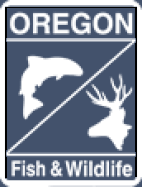Willamette steelhead on verge of extinction due to
increasing sea lion presence at Willamette Falls

SALEM, Ore. – One of Oregon and the Pacific Northwest’s iconic fish, native steelhead trout, have been migrating over Willamette Falls in Portland to spawn in Cascade Mountain rivers for millennia. They are now at high risk of going extinct, based on a new analysis by Oregon Department of Fish and Wildlife.
Listed for protection under the federal Endangered Species Act (ESA) in 1999 due primarily to the impacts of federal dams and habitat loss, wild native Willamette steelhead have now slipped to high risk of extinction. Willamette steelhead now face a new and growing threat from male sea lions that have learned to exploit the fish as they congregate below Willamette Falls before navigating upriver to spawn.
Continuing a decade-long downward trend, the number of wild steelhead returning to the upper Willamette this year was the lowest on record, with only 512 fish passing above the Willamette Falls. ODFW scientists found that sea lions consumed at least one quarter of the wild steelhead run and warned that if sea lion predation continues at these levels, there is an up to 90 percent probability that at least one wild steelhead population will go extinct as a direct result of the predation. The near-term risk of wild steelhead extinction can be significantly reduced or avoided by limiting sea lion access to Willamette Falls.
“We know what the problem is and have seen this coming for about a decade, we just couldn’t take action to prevent it,” said Dr. Shaun Clements from ODFW.
California sea lions have expanded along the West Coast over the past four decades to a population of nearly 300,000 animals coast-wide today. As numbers increased, a small proportion of sea lions – all males – have expanded their range into freshwater areas where migrating salmon and steelhead are especially vulnerable, including in places such as Ballard Locks in Washington, Bonneville Dam, and at the Willamette Falls, where fish tend to congregate before moving upstream. At these locations, predation by sea lions is especially high and adversely impacts salmon, steelhead, and sturgeon. In the 1980s, sea lion predation on winter steelhead at Ballard Locks in Seattle effectively destroyed the Lake Washington stock.
“Removal of a few problem individuals will have no impact on the overall sea lion population but can significantly benefit ESA-listed fish,” said Robin Brown, lead scientist for ODFW’s marine mammal program.
Any solution to address the threats to wild fish populations will have to strike a balance between the recovery of imperiled salmon and steelhead populations and the ongoing conservation of sea lions. Also at stake are significant regional investments in recovery efforts, such as improvements in fish passage at dams, restoration of fish habitat, and implementation of fishing regulations that prohibit anglers from harvesting wild fish. ODFW scientists have determined that curtailing the immediate impact created by sea lion predation is essential to saving the steelhead from extinction to support the success of long-term recovery efforts.
Sea lions are protected under the federal Marine Mammal Protection Act (MMPA). The MMPA, unlike the ESA, has fewer tools for managers to use to balance the conservation of predators and prey and prevent these situations in locations where fish are most vulnerable. Sections of the MMPA were revised in 1994 to allow limited management ofsea lions for the purpose of protecting ESA-listed salmon and steelhead. Unfortunately, the revisions do not allow for proactive management and cannot address emergencies like that occurring at Willamette Falls.
“We are in on-going discussions with state and tribal fishery managers and several stakeholder groups,” said Dr. Clements, “Given the situation at Willamette Falls, everyone is united in their call for swift action, and ODFW stands ready to provide expertise to the Northwest congressional delegation on a bipartisan, compromise bill to revise the MMPA to address these emergency situations without undermining the strength and importance of this law.” Bills in the House and Senate; H.R. 2083, sponsored by Rep. Jamie Herrera Beutler (R-Wash.) and Rep. Kurt Schrader (D-Ore.), and S 1702, sponsored by Sen. James Risch (R-Idaho), represent the first steps toward that goal.
“We are at a point where any more delays in the Willamette may condemn this run to extinction,” Clements said. “We need to act now or extinction may be our legacy.”
Upper Willamette wild steelhead have been listed as “threatened” under the federal ESA since March 1999. ODFW has not allowed harvest of these fish for more than 20 years. California sea lion populations are robust, and the animals are not listed under the Endangered Species Act, but are protected under the federal Marine Mammal Protection Act.
###
Contact:
Dr. Shaun Clements, (541) 223-8437
Rick Swart, (971) 673-6038
NOAA Antibusiness Plan for Coquille River ~ Public Private Property Partnership
ODFW ~ Commercial Crabbing Closed From Coos Bay North Jetty to Heceta Head
ODFW seeks Landowner Representatives for Access & Habitat Program – by Jan. 30
OR State Land Board Public Meeting December 13, 2016 ~ Sell the Elliot Forest
ODFW ~ Deer virus confirmed in Coos County
ODFW ~ Hosts Town Hall On Proposed 2017-19 budget North Bend May 4, 2016
ODFW ~ Commission Meeting in Bandon Friday April 22, 2016
ODFW ~ Harassing Cormorant to Protect Salman but Still a Crime for the People
ODFW ~ Public Meeting Coquille Valley Wildlife Area Discussion Wed. March 2, 2016
OFRI ~ Fish Passage & Habitat Workshop Wednesday, March 9, 2016
NOAA Proposed Recovery Plan for Coho Salmon September 2015
Fish and Wildlife Commission delists wolves statewide in split vote (4-2)
Coos Bay Area Chamber of Commerce Breakfast Meeting w/ODFW October 16, 2015
Coos County Approves Nature Conservancy's Tide Gate for China Camp Creek
ODFW ~ Conservation Opportunity Areas for Stealing Private Property

 RSS Feed
RSS Feed
